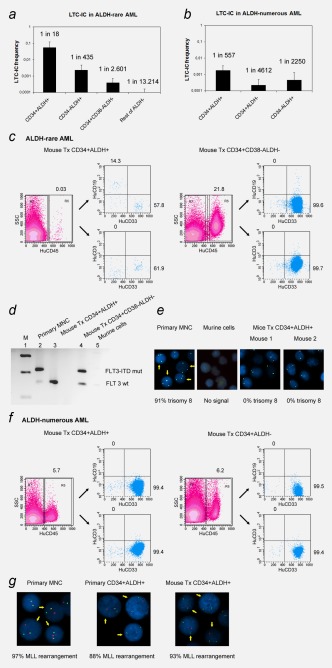Figure 3.

Colony formation potential and engraftment potential of cell subpopulations derived from patients with ALDH‐rare and ALDH‐numerous AML. (a) LTC‐IC frequencies of CD34+ALDH+ cells was highest, followed by CD34−ALDH+, CD34+CD38− ALDH‐ and other ALDH‐ cells (rest of ALDH‐) derived from patients with ALDH‐rare AML. (b) LTC‐IC frequencies of CD34+ALDH+ cells derived from patients with ALDH‐numerous AML were much lower than their counterparts derived from those with ALDH‐rare AML, but significantly higher than other populations including CD34+ALDH− and CD34−ALDH+ cells. (c) CD34+ALDH+ cells derived from patients with ALDH‐rare AML were capable of multilineage engraftment in NSG mice (mouse tx CD34+ALDH+), while CD34+CD38−ALDH‐ gave rise only to CD33+ myeloid cells (mouse tx CD34+CD38−ALDH−). (d) FLT3‐ITD detection revealed that engrafted cells from mice transplanted with CD34+ALDH+ cells expressed FLT3‐wild type. In contrast, FLT3‐ITD was positive in engrafted human cells of mice transplanted with CD34+CD38−ALDH− cells. (e) FISH analysis confirmed the nonleukemic nature of the CD34+ALDH+ progenies with cells being trisomy 8‐negative. (f and g) for patients with ALDH‐numerous AML, AML engraftment was always found upon transplantation of CD34+ALDH+ as well as CD34+ALDH− subsets, demonstrated by FACS and FISH analysis. Percentages of engrafted human cells with the proportions of CD33+, CD19+ and CD3+ cells are depicted in the FACS plots; mutated cells are marked with arrows in the FISH images. M: marker, wt: wild type, mut: mutation.
